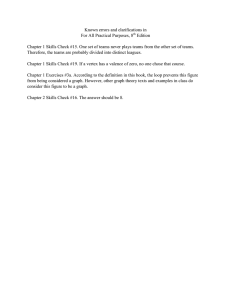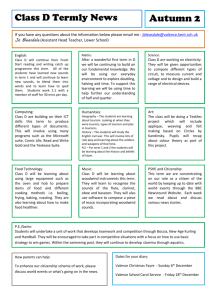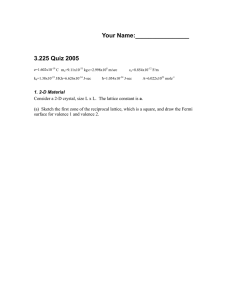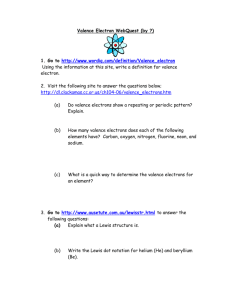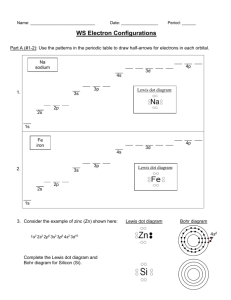Text Beautifier: An Affective-Text Tool to Tailor Written Text
advertisement
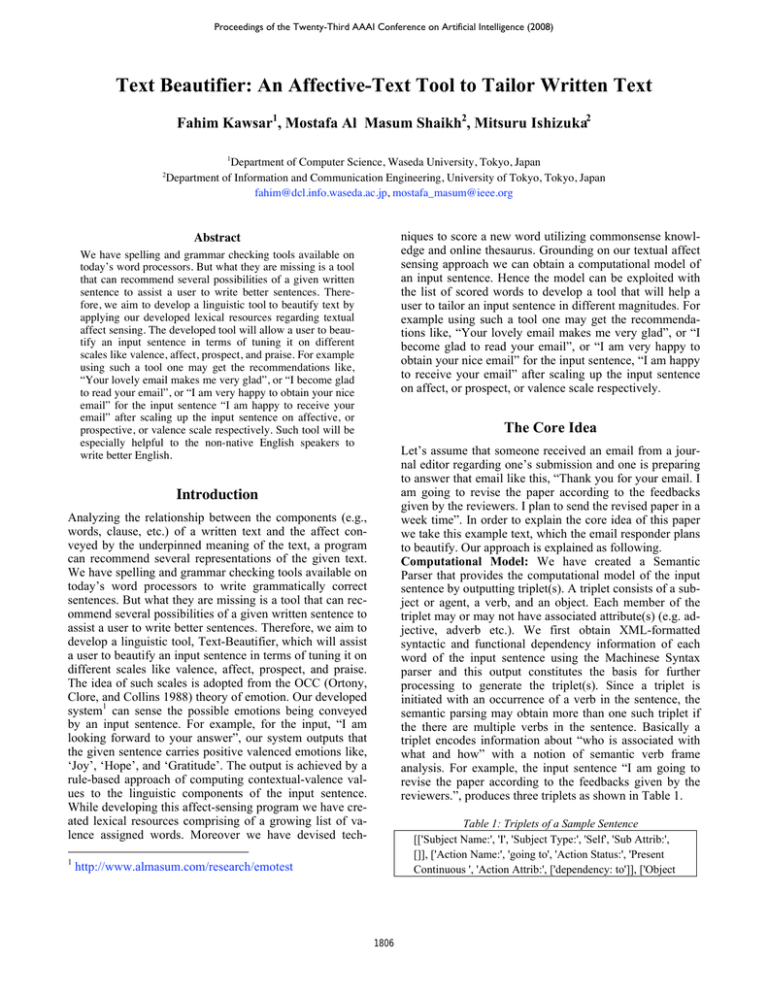
Proceedings of the Twenty-Third AAAI Conference on Artificial Intelligence (2008) Text Beautifier: An Affective-Text Tool to Tailor Written Text Fahim Kawsar1, Mostafa Al Masum Shaikh2, Mitsuru Ishizuka2 1 2 Department of Computer Science, Waseda University, Tokyo, Japan Department of Information and Communication Engineering, University of Tokyo, Tokyo, Japan fahim@dcl.info.waseda.ac.jp, mostafa_masum@ieee.org niques to score a new word utilizing commonsense knowledge and online thesaurus. Grounding on our textual affect sensing approach we can obtain a computational model of an input sentence. Hence the model can be exploited with the list of scored words to develop a tool that will help a user to tailor an input sentence in different magnitudes. For example using such a tool one may get the recommendations like, “Your lovely email makes me very glad”, or “I become glad to read your email”, or “I am very happy to obtain your nice email” for the input sentence, “I am happy to receive your email” after scaling up the input sentence on affect, or prospect, or valence scale respectively. Abstract We have spelling and grammar checking tools available on today’s word processors. But what they are missing is a tool that can recommend several possibilities of a given written sentence to assist a user to write better sentences. Therefore, we aim to develop a linguistic tool to beautify text by applying our developed lexical resources regarding textual affect sensing. The developed tool will allow a user to beautify an input sentence in terms of tuning it on different scales like valence, affect, prospect, and praise. For example using such a tool one may get the recommendations like, “Your lovely email makes me very glad”, or “I become glad to read your email”, or “I am very happy to obtain your nice email” for the input sentence “I am happy to receive your email” after scaling up the input sentence on affective, or prospective, or valence scale respectively. Such tool will be especially helpful to the non-native English speakers to write better English. The Core Idea Let’s assume that someone received an email from a journal editor regarding one’s submission and one is preparing to answer that email like this, “Thank you for your email. I am going to revise the paper according to the feedbacks given by the reviewers. I plan to send the revised paper in a week time”. In order to explain the core idea of this paper we take this example text, which the email responder plans to beautify. Our approach is explained as following. Computational Model: We have created a Semantic Parser that provides the computational model of the input sentence by outputting triplet(s). A triplet consists of a subject or agent, a verb, and an object. Each member of the triplet may or may not have associated attribute(s) (e.g. adjective, adverb etc.). We first obtain XML-formatted syntactic and functional dependency information of each word of the input sentence using the Machinese Syntax parser and this output constitutes the basis for further processing to generate the triplet(s). Since a triplet is initiated with an occurrence of a verb in the sentence, the semantic parsing may obtain more than one such triplet if the there are multiple verbs in the sentence. Basically a triplet encodes information about “who is associated with what and how” with a notion of semantic verb frame analysis. For example, the input sentence “I am going to revise the paper according to the feedbacks given by the reviewers.”, produces three triplets as shown in Table 1. Introduction Analyzing the relationship between the components (e.g., words, clause, etc.) of a written text and the affect conveyed by the underpinned meaning of the text, a program can recommend several representations of the given text. We have spelling and grammar checking tools available on today’s word processors to write grammatically correct sentences. But what they are missing is a tool that can recommend several possibilities of a given written sentence to assist a user to write better sentences. Therefore, we aim to develop a linguistic tool, Text-Beautifier, which will assist a user to beautify an input sentence in terms of tuning it on different scales like valence, affect, prospect, and praise. The idea of such scales is adopted from the OCC (Ortony, Clore, and Collins 1988) theory of emotion. Our developed system1 can sense the possible emotions being conveyed by an input sentence. For example, for the input, “I am looking forward to your answer”, our system outputs that the given sentence carries positive valenced emotions like, ‘Joy’, ‘Hope’, and ‘Gratitude’. The output is achieved by a rule-based approach of computing contextual-valence values to the linguistic components of the input sentence. While developing this affect-sensing program we have created lexical resources comprising of a growing list of valence assigned words. Moreover we have devised tech1 Table 1: Triplets of a Sample Sentence [['Subject Name:', 'I', 'Subject Type:', 'Self', 'Sub Attrib:', []], ['Action Name:', 'going to', 'Action Status:', 'Present Continuous ', 'Action Attrib:', ['dependency: to']], ['Object http://www.almasum.com/research/emotest 1806 crease the strength of the sentence our approach is to reduce or increase the contextual valence of the Triplets (Table 1) by picking up lower or upper valenced synonyms. Affect Scale: The strength of the affective scale is calculated according to the output of our system [2] which gives the named emotional affinity of the input sentence. The example sentence shows the affinity with “Joy (57.5%)”, “Happy-for (46%)”, “Hope (34.5%)”, “Love (23%)” and “Satisfaction (11.5%)” emotions according to our system. Since the maximum strength is found to be 57.5%, the sentence gets the value of 6 on affective scale. In order to make the sentence stronger on affective scale our approach is to add appropriate and higher valenced adjectives with the object (e.g., prudent reviewer) of a triplet. Similarly, to make the sentence weaker on affective scale our approach is to either eliminate the adjectives or use lower valenced adjectives without reversing the global sentiment of the sentence. Prospect Scale: “Prospect” and “Praise” values indicate the lexical affinity of an action word with respect to “desirable or undesirable”, and “praiseworthiness or blameworthiness”, respectively. According to the OCC model, prospect of an event involves a conscious expectation that it will occur in the future, and the value can be either “positive” or “negative”. For example, for the events like, “admit to university”, “revise paper”, and “give feedback”, we get +9.375, +8.728, and +4.921 as the valence values for the events, respectively. So in order to make a sentence more prospective our target is to increase the prospective value of the events represented by the triplets. Praise Scale: According to the appraisal structure of an event mentioned in the OCC model, an event can be assessed as either “praiseworthy” or “blameworthy”. Therefore we have either a positive or negative score for a verb to associate “praise” or “blame” to the list of action words without a context. For example, let’s consider these events, “pass final exam”, “forget friend’s birthday”, and “revise paper”. For these events we get +7.95, -9.31, and +3.87, respectively as the scores of the events on praise scale. Therefore our approach to tailor the sentence on this scale is to select the appropriately valenced synonymous verbs without revering the meaning of the sentence. Name:', '', 'Object Type:', '', 'Object Attrib:', []]] [['Subject Name:', 'I', 'Subject Type:', '', 'Sub Attrib:', []], ['Action Name:', 'revise', 'Action Status:', 'Infinitive ', 'Action Attrib:', ['dependency: by']], ['Object Name:', 'paper', 'Object Type:', 'N NOM SG', 'Object Attrib:', ['Determiner: the', 'PREP: according to']]] [['Subject Name:', 'reviewer', 'Subject Type:', 'N NOM SG', 'Sub Attrib:', []], ['Action Name:', 'give', 'Action Status:', 'passive Past Particle', 'Action Attrib:', []], ['Object Name:', 'feedback', 'Object Type:', 'N NOM PL ', 'Object Attrib:', ['Determiner: the']]] GUI: The GUI of the prototype application is shown in Figure 1. The system takes a sentence as an input. Clicking on “Measure” button does the affect sensing according to our system [2] and measure the valence, affect, prospect and praise values of the input sentence to be shown on the “Beauty-Scale” panel represented by four scales. A user can interact with the sliders of the scales by dragging to right or left. For example, if a user wants to make the input sentence more affective but more valenced, he drags the sliders of the “Affect Scale” and “Valence Scale” to right respectively. Each scale varies from 1 to 10, which represent the overall strength of the sentence on that particular scale. How the strength is calculated is explained in the next subsections. By moving the sliders back and forth a user can observer the recommended sentence to accept or tailor further. Conclusion Figure 1: Prototype Application GUI At present we are revising the valence values of the words and developing the rules to incorporate different subtle features of writing well structured sentences. Such tool will be especially helpful to the non-native English speakers to write better English. Valence Scale: The valence scale’s strength is calculated according to our developed tool SenseNet, which calculates the contextual-valence of the words using rules and prior-valence values of the words of the input sentence. It outputs either a negative or positive value that indicates a numerical measure of negative and positive sentiments carried by the sentence. For the ongoing example input we get +7.44 as the strength on the valence scale. This indicates that the sentence is a positive one and the beautification will occur towards the positive direction while interacting with the sliders on each scale. In order to increase or de- References Ortony, A., Clore, G.L. and Collins, A. 1988. The Cognitive Structure of Emotions, Cambridge University Press 1807
